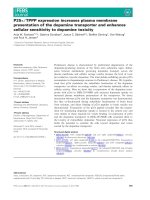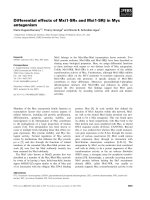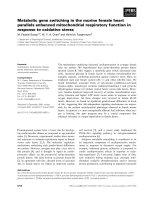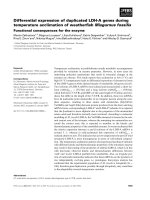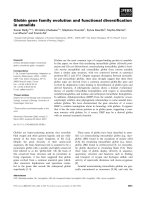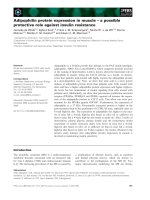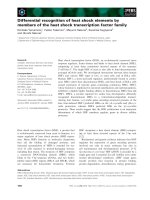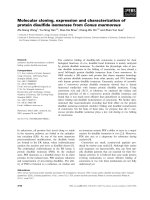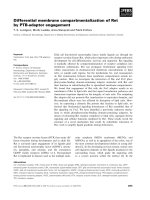Báo cáo khoa học: Differential gene expression profiles of red and green forms of Perilla frutescens leading to comprehensive identification of anthocyanin biosynthetic genes doc
Bạn đang xem bản rút gọn của tài liệu. Xem và tải ngay bản đầy đủ của tài liệu tại đây (396.75 KB, 9 trang )
Differential gene expression profiles of red and green
forms of Perilla frutescens leading to comprehensive
identification of anthocyanin biosynthetic genes
Mami Yamazaki
1,2
, Masahisa Shibata
1
, Yasutaka Nishiyama
1,3,
*, Karin Springob
1,
,
Masahiko Kitayama
3
, Norimoto Shimada
4
, Toshio Aoki
4
, Shin-ichi Ayabe
4
and Kazuki Saito
1,5
1 Graduate School of Pharmaceutical Sciences, Chiba University, Japan
2 CREST, Japan Science and Technology Agency, Kawaguchi, Japan
3 Institute of Life Science, Ehime Women’s College, Uwajima, Japan
4 Department of Applied Biological Sciences, Nihon University, Fujisawa, Japan
5 RIKEN Plant Science Center, Yokohama, Japan
The plant chemovarietal forms, in which only the
chemical constituents of particular secondary products
differ, are interesting and useful for better understand-
ing of molecular regulation underlying the production
of secondary products. In particular, combinatorial
analysis of transcriptome and metabolic profiles pro-
vides excellent clues for decoding the function of
unidentified genes, if these analytical platforms are
available, as in the case of a model plant, Arabi-
dopsis thaliana [1–3]. However, as no microarray chips
Keywords
anthocyanin; chalcone isomerase;
glutathione S-transferase; PCR-select
subtraction; Perilla frutescens
Correspondence
K. Saito, Graduate School of Pharmaceutical
Sciences, Chiba University, Yayoi-cho 1-33,
Inage-ku, Chiba 263 8522, Japan
Fax: +81 43 290 2905
Tel: +81 43 290 2904
E-mail:
Present address
*Ehime University, Matsuyama, Japan
Donald Danforth Plant Science Center,
St Louis, MO, USA
Database
The sequences reported in this article have
been deposited in the DDBJ under the
accession numbers AB362191 (PfGST1) and
AB362192 (PfCHI1)
(Received 16 February 2008, revised 30
March 2008, accepted 7 May 2008)
doi:10.1111/j.1742-4658.2008.06496.x
Differential screening by PCR-select subtraction was carried out for
cDNAs from leaves of red and green perilla, two chemovarietal forms of
Perilla frutescens regarding anthocyanin accumulation. One hundred and
twenty cDNA fragments were selected as the clones preferentially expressed
in anthocyanin-accumulating red perilla over the nonaccumulating green
perilla. About half of them were the cDNAs encoding the proteins related
presumably to phenylpropanoid-derived metabolism. The cDNAs encoding
glutathione S-transferase (GST), PfGST1, and chalcone isomerase (CHI),
PfCHI1, were further characterized. The expression of PfGST1 in an Ara-
bidopsis thaliana tt19 mutant lacking the GST-like gene involved in vacuole
transport of anthocyanin rescued the lesion of anthocyanin accumulation
in tt19, indicating a function of PfGST1 in vacuole sequestration of antho-
cyanin in perilla. The recombinant PfCHI1 could stereospecifically convert
naringenin chalcone to (2S)-naringenin. PfGST1 and PfCHI1 were pre-
ferentially expressed in the leaves of red perilla, agreeing with the accumu-
lation of anthocyanin and expression of other previously identified genes
for anthocyanin biosynthesis. These results suggest that the genes of the
whole anthocyanin biosynthetic pathway are regulated in a coordinated
manner in perilla.
Abbreviations
CHI, chalcone isomerase; GST, glutathione S-transferase; GUS, b-glucuronidase.
3494 FEBS Journal 275 (2008) 3494–3502 ª 2008 The Authors Journal compilation ª 2008 FEBS
are available for most of the plants exhibiting interest-
ing chemovarieties, alternative technologies should be
applied to obtain comprehensive differential gene
expression profiles [4,5].
In Perilla frutescens (Labiatae), a medicinal plant
common in east Asian countries, there are two chem-
ovarietal forms, the red form (red perilla, ‘Aka-jiso’ in
Japanese) and the green form (green perilla, ‘Ao-jiso’),
differing in the accumulation of anthocyanins [6].
Chemical analysis indicated that only red perilla, but
not green perilla, produces anthocyanins, malonylsh-
isonin [cyanidin 3-O-[6¢¢-O-(E)-p-coumaroyl]-b-d-gluco-
pyranoside-5-O-(6¢¢¢-O-malonyl)-b-d-glucopyranoside]
being the main pigment [7] (supplementary Fig. S1).
Health-beneficial properties of anthocyanins are widely
recognized, and they are mainly ascribed to the antiox-
idant activity of anthocyanins [8]. In the Japanese
Pharmacopoeia, only red perilla is registered as a tra-
ditional Japanese ⁄ Chinese crude drug. Differential
gene expression analysis of the two forms by cDNA-
differential display led to the identification of several
genes involved in biosynthetic reactions (structural
genes) and regulation of the expression of biosynthetic
genes (regulatory genes) [4,9–11]. However, the cover-
age of gene expression profile by cDNA-differential
display seems still incomplete, given the lack of a few
genes in the entire biosynthetic pathway of anthocya-
nins in the collected gene repertoire obtained to date.
Therefore, a more complete analysis for differential
gene expression profiles is needed.
The participation of glutathione S-transferase
(GST)-like protein in the vacuole transport of anthocy-
anin and proanthocyanidin is still ill-defined. Three
genes, Bz2 from maize [12], AN9 from petunia [13],
and TT19 from A. thaliana [14], encoding GST-like
proteins have been isolated by a forward genetic
approach for mutants with changed color of seeds and
flowers, and the involvement of these genes in seques-
tration of anthocyanin and proanthocyanidin into vac-
uoles has been experimentally proven. However, the
questions of whether this GST-like protein is com-
monly necessary for transport of anthocyanin in any
other plant species, and if so, how diverse the GST
proteins are in terms of their structures and functions,
remain to be solved by isolation and characterization
of functional orthologs from diverse plant species.
In the present study, we conducted differential gene
expression profiling between the anthocyanin-produc-
ing red form and the nonproducing green form by
PCR-select subtraction. This approach elucidated the
whole picture of differential gene expression behind
the differential anthocyanin production in the two
chemovarietal forms. The functions of two new differ-
entially expressed genes obtained by this method cod-
ing for GST and chalcone isomerase (CHI) have been
identified and characterized by in vivo and in vitro
studies.
Results and Discussion
PCR-select subtraction analysis gave the
comprehensive repertoire of genes differentially
expressed in red perilla
PCR-select subtraction analysis was conducted
between cDNAs from the leaves of red perilla and
green perilla. As a result of the first screening, 576
clones each were selected as specific candidates for red
perilla and green perilla. These clones were further
delimited to 120 clones specific for red perilla and 24
clones specific for green perilla by dot-blot hybridiza-
tion. The (partial) sequences of these delimited clones
were determined, and the sequence homologies were
analyzed by blast-x (Fig. 1 and supplementary
Table S1). Of 120 red perilla-specific clones in Fig. 1,
nearly half of them (56 clones) were genes related to
secondary metabolism, in particular for flavonoid bio-
synthesis, indicating the preferential expression of
genes involved in flavonoid metabolism in red perilla.
Of 24 green perilla-specific clones, in contrast, no
clones were related to secondary metabolism. These
results indicate a dominant contribution of secondary
metabolism-related genes in the gene repertoire prefer-
entially expressed in red perilla.
Among the genes specifically expressed in red perilla
listed in supplementary Table S1, six genes, chalcone
synthase (CHS), flavanone 3-hydroxylase (F3H),
dihydroflavonol reductase (DFR), anthocyanidin syn-
thase (ANS), flavonoid 3-glucosyltransferase (3GT), and
anthocyanin acyltransferase (AAT), are the structural
genes coding for the biosynthetic enzymes, which have
been previously characterized [15–17]. Two genes pre-
sumably coding for CHI and GST have not been iso-
lated and are thus new from perilla. One of these two
genes, PfGST1, was subjected to further analysis as
described below. With respect to the regulatory genes,
in addition to the previously isolated two regulatory
genes, bHLH-F3G1 [18] and Myb-P1 [9], another basic
helix-loop-helix (bHLH) protein gene was newly
cloned. The gene, 8R6, coding for an uncharacterized
tonoplast membrane protein that has been obtained by
mRNA differential display [6], was again isolated by
PCR-select subtraction. The gene encoding caffeoyl-
CoA-3-O-methyltransferase, involved in phenylpro-
panoid metabolism leading to lignin formation, was
specifically expressed in red perilla, suggesting a higher
M. Yamazaki et al. Anthocyanin biosynthetic genes from Perilla
FEBS Journal 275 (2008) 3494–3502 ª 2008 The Authors Journal compilation ª 2008 FEBS 3495
activity of phenylpropanoid metabolism in red perilla
than in the green form. However, even by PCR-select
subtraction, not all genes that are differentially
expressed and involved in anthocyanin production
have been isolated. The gene encoding anthocyanin-5-
O-glucosyltransferase, predominantly expressed in red
perilla [10], failed to be cloned by this PCR-select
method. Thus, it would be desirable to apply several
different technologies to obtain the list of genes
expressing in a chemovariety-specific manner.
In addition to anthocyanin biosynthetic genes, red
perilla expressed a set of genes activated by light, such
as ATP synthase of photophosphorylation, one-helix
protein of photosystem II, Rieske [2Fe–2S] iron–sulfur
protein tic 55, RuBisCo activase, and T-protein of
glycine decarboxylase, involved in photorespiration.
This suggested that the gene expression regulated by
light signaling might be different between the red and
green forms of perilla, in addition to gene expression
for anthocyanin biosynthesis.
As a green perilla-specific gene, a gene encoding an
F-box protein was isolated. This might suggest the
possible involvement of F-box proteins in the degra-
dation of certain proteins related to the speciation of
two forms. Although the content of rosmarinic acid is
higher in green perilla than in red perilla [7], no genes
related to rosmarinic acid biosynthesis were specifically
expressed in green perilla. This is presumably due to a
slight difference of gene expression that could not be
differentiated by the PCR-select method between two
chemovarietal forms, or a difference of accumulation
levels resulting simply from the dominant metabolic
flow of phenylpropanoid precursors to rosmarinic acid
formation rather than to anthocyanin production.
Another possibility is that translational or post-trans-
lational regulation operates for this pathway.
Molecular characterization of PfGST1 encoding
GST-like protein
Ten clones partially coding for GST were isolated as
red-perilla-specific genes by PCR-select subtraction. Of
these 10 clones, four and six, respectively, encoded the
N-terminal and the C-terminal parts of a GST-like
protein homologous to AN9 [13] and TT19 [14],
involved in transport of anthocyanin to the vacuoles.
As the N-terminal clones contained a putative first
ATG codon together with an in-frame stop codon in
the upstream region, the full-length clones containing
the entire coding region were amplified by PCR using
cDNA obtained from red perilla leaves as a template.
The sequence analysis of 19 full-length clones indicated
that they were divided into two groups, with a single
nucleotide change that resulted in no amino acid sub-
stitution. This is presumably due to the microhetero-
geniety of the genomic sequences. The clone obtained
from the majority of 16 clones was designated as
PfGST1. The deduced 214 amino acid sequences of
PfGST1 exhibited 61% and 50% identities, respec-
tively, with those of AN9 from petunia [13] and TT19
from A. thaliana [14] (supplementary Fig. S2). Phylo-
genetic analysis of deduced amino acid sequences of
GST-like proteins (Fig. 2) indicated that PfGST1
forms a subfamily together with AN9 and TT19, but
distinct from the maize Bz2 protein [12], which plays a
similar role in uptake of anthocyanin into vacuoles.
This presumably reflects the difference in the origin of
these proteins, either from eudicot or monocot plants.
Red specific (120) Green specific (24)
Others (13)
Cell wall protein (2)
Latex-like protein (2)
F-box protein (3)
Photo-response genes (1)
Signal transduction/Transcriptional factor (1)
Primary metabolism (2)
Others (34)
Transporter/membrane protein (7)
Photo-response genes (5)
Signal transduction/Transcriptional factor (14)
Secondary metabolism (56)
Primary metabolism (4)
AB
Fig. 1. Profiling of fragments with PCR-
select cDNA subtraction in P. frutescens.
Anthocyanin biosynthetic genes from Perilla M. Yamazaki et al.
3496 FEBS Journal 275 (2008) 3494–3502 ª 2008 The Authors Journal compilation ª 2008 FEBS
The expression pattern of the PfGST1 gene was
investigated by semiquantitative RT-PCR for the
RNA from leaves and stems of red and green perilla
(Fig. 3). Predominant expression was observed in
leaves of red perilla, followed by stems of red perilla.
Very weak but apparent expression was detected in
stems of green perilla; however, the transcript of
PfGST1 was hardly detected in leaves of green perilla.
These observed expression patterns were in good
agreement with the anthocyanin accumulation profiles
in those tissues of red and green perilla as reported
previously [7], indicating the involvement of PfGST1
in anthocyanin accumulation in perilla plants. A
GST-like protein, presumably involved in anthocyanin
accumulation in orange fruit, was reported to be pref-
erentially expressed in pigmented orange fruit [19], sug-
gesting the general participation of GST-like proteins
in anthocyanin transport.
Functional confirmation of the involvement of
PfGST1 in anthocyanin accumulation by using
Arabidopsis as a host plant
To investigate the function of PfGST1 in planta, the
PfGST1 cDNA was transferred by Agrobacterium-
based transformation into an A. thaliana tt19 mutant
[14] lacking the TT19 GST-like gene that is responsi-
ble for uptake of anthocyanin into the vacuoles. The
expression of the PfGST1 cDNA was driven by the
promoter from cauliflower mosaic virus 35S RNA
(35S) in a constitutive manner (Fig. 4A). Under
sucrose stress, the accumulation of anthocyanin in
petioles was observed in the transgenic plants express-
AtGSTF10
AtGSTF12 (TT19)
AN9
PfGST1
AtGSTZ1
Bz2
AtGSTU19
AtGSTU5
AtGSTU7
AtGSTF8
AtGSTF2
AtGSTF6
AtGSTF7
61%
50%
Fig. 2. Phylogenetic tree of GSTs. The neighbor-joining tree was
constructed on the basis of deduced amino acid sequences of
PfGST1 (in this study), petunia AN9 (Y07721), maize Bz2 (X81971),
and Arabidopsis GSTs [AtGSTF2 (NM_116486), AtGSTF6
(NM_100174), AtGSTF7 (NM_100173), AtGSTF8 (NM_180148),
AtGSTF10 (NM_128639), AtGSTF12 (NM_121728), AtGSTU5
(NM_128499), AtGSTU7 (NM_128496), AtGSTU19 (NM_106485),
and AtGSTZ1 (NM_201671)]. The deduced amino acid sequence of
PfGST1 showed 61% and 50% identities, respectively, with those
of AN9 from petunia and AtGSTF12 (TT19) from A. thaliana. The
roles of PfGST1, AN9, AtGSTF12 (TT19) and Bz2 in anthocyanin
transport into vacuoles have been confirmed by experiments.
Red leaf
PfGST1 (×0.5)
Actin
PfGST1 (×1.0)
PfCHI1 (×0.1)
PfCHI1 (×0.3)
Red stem
Green leaf
Green stem
Fig. 3. Expression of PfGST1 and PfCHI1 in Perilla frutescens.
Semiquantitative RT-PCR of PfGST1 using 0.5 lL or 1.0 lL of tem-
plate cDNA and PfCHI1, with 0.1 lL or 0.3 lL of template cDNA
together with Actin as a standard. The cDNAs from leaves and
stems of red and green perilla were used as templates.
35S-PfGST1/tt19 35S-GUS/tt19
35S-PfGST1 (pGWB2)
RB
A
B
LB
Km
r
35S promoter
PfGST1
Hyg
r
Nos-T
Fig. 4. Functional complementation of tt19 mutants with PfGST1.
(A) T-DNA construct in the binary vector used in this study. (B) Phe-
notypes of T
1
seedling of transgenic Arabidopsis plants transformed
with 35S-PfGST1 or 35S-GUS as control. Left panel: 35S-
PfGST1 ⁄ tt19. All of 10 resistant plants accumulated anthocyanin in
the petiole, as indicated by arrowheads. Right panel: 35S-GUS ⁄ tt19.
All of five resistant plants did not accumulate anthocyanin.
M. Yamazaki et al. Anthocyanin biosynthetic genes from Perilla
FEBS Journal 275 (2008) 3494–3502 ª 2008 The Authors Journal compilation ª 2008 FEBS 3497
ing the PfGST1 cDNA, whereas the nontransformed
tt19 plants and the negative control plants expressing
the bacterial b-glucuronidase (GUS) gene did not
accumulate anthocyanins (Fig. 4B). All 10 indepen-
dent transgenic plants expressing the PfGST1 cDNA
checked by RT-PCR contained more anthocyanin
than tt19 plants, and three of them accumulated
higher amounts of anthocyanins than the wild-type
plants (Fig. 5). There was a rough correlation between
the accumulation of anthocyanin and the expression
of PfGST1 (data not shown). The patterns of antho-
cyanin molecules that accumulated in the transgenic
plants were analyzed by HPLC-MS (Fig. 6). The pat-
tern of the transformant was almost identical to that
of the wild-type plants, showing a cyanidin-derived
anthocyanin [7] as the main compound. All these
results indicated that PfGST1 can functionally com-
plement the mutation of the TT19 gene encoding
GST-like protein that participates in uptake of antho-
cyanin into vacuoles. A carnation anthocyanin mutant
was complemented by the expression of maize Bz2
and petunia AN9 [20], indicating again the universal
necessity of GST-like proteins in anthocyanin accumu-
lation and the interspecies functional compatibility of
these proteins.
To investigate whether PfGST1 can influence
the accumulation of tannins (proanthocyanidins) in
Arabidopsis seeds, the color of seed coats due to pro-
anthocyanidin accumulation was examined for the
transgenic plants (supplementary Fig. S3). Apparently,
PfGST1 failed to rescue the function of the TT19 gene,
which supports the accumulation of proanthocyanidins
in the Arabidopsis seed coat [14]. Also, the AN9 gene
from petunia was incapable of transporting proantho-
cyanidin, although it could participate in the transport
of anthocyanin [14], as observed in the case of
PfGST1. As the protein sequence of PfGST1 was clo-
ser to that of AN9 than to that of TT19, this sequence
difference may be responsible for functional discrimi-
nation with respect to uptake of proanthocyanidin.
Further analysis of the peptide region or amino acid
residues involved in this discrimination would be inter-
esting.
Molecular characterization of PfCHI1
encoding CHI
Two clones exhibiting high homology with CHI from
grapevine were obtained by PCR-select subtraction in
the list of red perilla-specific genes. Sequence analysis
0
2
4
6
8
10
12
14
WT
Total peak area
(Absorbance at 520 nm)
35S-PfGST1/tt19
16
tt19
X 10
6
Fig. 5. Anthocyanin contents of T
2
plants. Anthocyanin contents in
the leaf extracts are represented as total peak area of the chroma-
tograms at 520 nm. Extracts were prepared from rosette leaves of
10 independent transgenic plants transformed with 35S-PfGST1.
Fig. 6. HPLC chromatograms of anthocya-
nins at 520 nm in the extracts of rosette
leaves of transgenic Arabidopsis. (A) tt19.
(B) 35S-GUS ⁄ tt19. (C) 35S-PfGST1 ⁄ tt19.
(D) Wild-type plant. (E) Structures of three
major anthocyanins accumulated in Arabid-
opsis [1]. Glu, glucose; Xyl, xylose; p-Cou,
p-coumaroyl; Sin, sinapoyl; Mal, malonyl.
Anthocyanin biosynthetic genes from Perilla M. Yamazaki et al.
3498 FEBS Journal 275 (2008) 3494–3502 ª 2008 The Authors Journal compilation ª 2008 FEBS
revealed that one of them, designated PfCHI1, con-
tained the entire ORF coding for the CHI protein.
The deduced 214 amino acid sequence exhibited 70%,
67% and 65% identities with those from Vitis vinifera,
Citrus sinensis and Lotus japonicus, respectively (sup-
plementary Fig. S4). Phylogenetic analysis (Fig. 7) sug-
gested that PfCHI1 belongs to the family of type I
CHIs, which comprises the CHI proteins utilizing only
6¢-hydroxychalcone (naringenin chalcone) as a sub-
strate, as opposed to the type II CHIs, which are
active on both 6¢-hydroxychalcones and 6¢-deoxychal-
cones found in leguminous plants [21].
The mRNA accumulation pattern of PfCHI1 was
investigated by semiquantitative RT-PCR (Fig. 3). The
most abundant accumulation was observed in red
leaves, followed by green leaves. Low levels of expres-
sion were detected in both red and green stems. These
expression patterns were slightly different from those
of PfGST1 and anthocyanin accumulation [7]. This
difference is presumably due to the fact that naringe-
nin formed by CHI is the substrate for not only antho-
cyanins but also general flavonoids.
To confirm the function of PfCHI1, the enzymatic
activity of the recombinant PfCHI1 protein was deter-
mined in vitro using naringenin chalcone as the sub-
strate. As shown in Fig. 8, the recombinant PfCHI1
protein could stereospecifically convert naringenin
chalcone to (2S)-naringenin, whereas the nonenzymatic
reaction gave racemic naringenin as product. These
results provided evidence that PfCHI1 encodes the
functional CHI protein.
Conclusions
PCR-select subtraction provided comprehensive pic-
tures of differential gene expression profiling between
the anthocyanin-producing red form and the nonpro-
ducing green form of P. frutescens. Among the differ-
entially expressed genes, two new genes have been
identified as coding for a GST-like protein involved in
anthocyanin transport in vacuoles and a type I CHI,
and their roles have been confirmed by in vivo and
in vitro studies. The expression levels of all the genes
involved in anthocyanin accumulation, including
PfGST1 and PfCHI1, was higher in red perilla. These
results indicate the tightly coregulated transcription of
all genes of the anthocyanin pathway in perilla.
Experimental procedures
Plant materials
The red and green forms of P. frutescens var. crispa were
grown on rock wool with a nutrient solution of Hyponex
(5-10-5) in a plant growth room for 16 weeks with a photo-
period of 18 h light (4500 lux) ⁄ 6 h dark at 25 °C. A. thali-
ana (ecotype Columbia) plants were grown in a growth
Vitis vinifera CHI
Citrus sinensis CHI
Medicago sativa CHI
Lotus japonicus CHI1
PfCHI1
Phaseolus vulgaris CHI
Lotus japonicus CHI2
Lotus japonicus CHI3
Type I
Type II
70%
Fig. 7. Phylogenetic tree of CHIs. Neighbor-joining tree based on
deduced amino acid sequences of PfCHI1, Citrus sinensis CHI
(AB011794), Lotus japonicus CHI1(AB054801), CHI2 (AB054802),
and CHI3 (AB073787), Medicago sativa CHI (M91079), Phaseo-
lus vulgaris CHI (S54703), and Vitis vinifera CHI (X75963). The
deduced amino acid sequence of PfCHI1 exhibited 70% identity
with that from V. vinifera.
PfCHI1
(2S)-Naringenin
(2S)-Naringenin
Naringenin
chalcone
(2R)-Naringenin
(2R)-Naringenin
A
B
No enzyme
Absorbance at 295 nm
010
Retention time (min)
20
Fig. 8. Chiral HPLC profiles of the reaction products of naringenin
chalcone with recombinant PfCHI1 expressed in Escherichia coli.
The recombinant E. coli BL21AI protein extract carrying pD17–
PfCHI1 was used for the assay as previously described [21]. The
2R- and 2S-naringenins were separated by reverse-phase chiral
chromatography with Chiralcel OD-RH (4.6 · 150 mm). (A) Recom-
binant PfCHI1. (B) Control (incubation without protein).
M. Yamazaki et al. Anthocyanin biosynthetic genes from Perilla
FEBS Journal 275 (2008) 3494–3502 ª 2008 The Authors Journal compilation ª 2008 FEBS 3499
chamber and used for transformation as described previ-
ously [1].
PCR-select subtraction
Total RNA was isolated from young leaves of red and
green P. frutescens around 4–5 h after exposure to light by
RNeasy Plant Mini Kit (Qiagen, Tokyo, Japan). PCR-select
subtraction was carried out between cDNAs from leaves of
red and green perilla as described previously [22,23].
cDNA cloning of PfGST1
To obtain a cDNA coding for the entire PfGST1 protein,
PCR amplification was carried out using a primer (GST-0,
5¢-ATGGTGGTTAAAGTGTATGGTGCAACC-3¢)andan
oligo-dT primer with the first-strand cDNA reverse-tran-
scribed from RNA of red perilla with Pyrobest DNA poly-
merase (Takara, Japan). The sequence of the GST-0 primer
containing the first Met codon was designed by alignment
analysis of four fragments obtained by PCR-select sub-
traction with the known GST genes. The protruding dA
residues were attached to the amplified fragment by Ex Taq
polymerase (Takara, Japan), and then the resulting frag-
ment was cloned into pGEM-T Easy (Promega, KK,
Tokyo, Japan) to give pGTE-PfGST1.
Construction of Agrobacterium-Ti plasmid
vector and plant transformation for PfGST1 by
GATEWAY technology
To attach attB sequences on both sides of PfGST1 cDNA,
two rounds of PCR reactions were performed with pGTE–
PfGST1 as the template. The sequences of primers were:
GST-1-f (5¢-AAAAAGCAGGCTACATGGTGGTTAAAG
TGTATGGTGCAAC-3¢) and GST-1-r (5¢-AGAAAGC
TGGGTTTATTTTGGGAGATCCATAACTTTTCTCC-3¢)
for the first round of PCR; and attB1 (5¢-GGGGACAAGT
TTGTACAAAAAAGCAGGCT-3¢) and attB2 (5¢-GGGG
ACCACTTTGTACAAGAAAGCTGGGT-3¢) for the sec-
ond round of PCR. The GATEWAY-compatible entry
clone pD221–PfGST1 was obtained through recombination
of the PCR product with pDONR221. After the sequence
of the insert of pD221–PfGST1 was verified, the insert was
transferred into a binary vector pGWB2 downstream of the
CaMV35S promoter to give pGWB2–PfGST1 for plant
transformation. The resulting binary vector pGWB2–
PfGST1 was introduced into A. tumefaciens C58C1
(GV3101) by a freeze–thaw method [24].
The A. thaliana tt19 mutant [14] was transformed with
pGWB2–PfGST1 and pGWB2–GUS, in which the expres-
sion of the Escherichia coli uidA gene, coding for GUS, was
controlled by the CaMV35S promoter, by the floral dip
method for in planta transformation [25]. Selection of trans-
formants was carried out on GM agar medium [26]
containing kanamycin (50 mgÆL
)1
) and hygromycin
(20 mgÆL
)1
). The transformation state of A. thaliana was
confirmed by PCR using the primers GST-1-f and GST-1-r
for the genomic DNA. The expression of the transgene was
studied by RT-PCR for the first-strand cDNA obtained
from the transformed Arabidopsis with the primers GST-1-f
and GST-1-r.
Anthocyanin determination
Aseptic Arabidopsis plants were grown on GM agar plates
for 2 weeks, and then transferred to GM agar plates supple-
mented with 10% sucrose for 1 week to induce the produc-
tion of anthocyanins by sucrose stress. Anthocyanins were
extracted with 5 l L of extraction solution (5% acetic acid,
45% methanol, and 50% water) per 1 mg of leaves with a
Mixer Mill MM300 (Qiagen). After centrifugation at 12 000 g
for 10 min, the supernatant solution was subjected to anal-
ysis of anthocyanins by LC-photodiode array-MS [Agilent,
ThermoQuest ⁄ Finnigan (San Jose, CA, USA) LCQ DECA]
as described previously [1].
Construction of the expression vector for
PfCHI1 by GATEWAY technology and expression
in E. coli
As one of two cDNA fragments isolated by PCR-select
subtraction designated as PfCHI1 was suggested to encode
the entire protein of CHI, by sequence comparison with
known CHI, the GATEWAY-compatible entry clone
pD221–PfCHI1 was constructed by attaching attB sites
using the primers CHI-1-f (5¢-AAAAAGCAGGCTA
CATGTCTGTGACTCAAGTCCAAGTGG-3¢) and CHI-
1-r (5¢-AGAAAGCTGGGTGCTAATTCTGGTTGAAC
AAGTGGGACAATCT-3¢). The PfCHI1 gene in pD221–
PfCHI1 was introduced into pDEST17, an expression vec-
tor in E. coli, to afford pD17–PfCHI1. E. coli BL21 AI
(Invitrogen, Carlsbad, CA, USA) was transformed with
pD17–PfCHI1, and the recombinant protein of PfCHI1
with a 6His tag at the N-terminus was expressed upon
induction by l-arabinose. After centrifugation at 6000 g for
5 min, bacteria were suspended in the extraction buffer
(50 mm potassium phosphate, pH 7.5, 50 mm NaCl, 1 mm
EDTA, 1 mm dithiothreitol) and disrupted by sonication.
The supernatant solution obtained by centrifugation was
used as the soluble protein fraction for SDS ⁄ PAGE and
enzyme assay.
Assay of CHI activity
CHI activity of the recombinant PfCHI1 protein was
assayed in vitro as described previously [21]. The enantio-
meric naringenin was separated by reverse-phase chiral
Anthocyanin biosynthetic genes from Perilla M. Yamazaki et al.
3500 FEBS Journal 275 (2008) 3494–3502 ª 2008 The Authors Journal compilation ª 2008 FEBS
chromatography with Chiralcel OD-RH (4.6 · 150 mm;
Daicel, Japan).
Semiquantitative RT-PCR
The first-strand cDNAs were obtained from RNA isolated
from leaves and stems of red and green perilla. Using the
first-strand cDNAs as templates, semiquantitative PCR (20
cycles) was carried out to determine the expression levels of
PfGST1 and PfCHI1. The expression of actin was used as
a control. The sequences of primers were: GST-0 and GST-
R-1 (5¢-GATATGAGGGCATCTAAAAATTATT-3¢) for
PfGST1; PfCHI-2 (5¢-CAAAATGTCTGTGACTCAAGT
CC-3¢) and CHIseq-r-1 (5¢-GACATTCATTGGTCACTGA
TAAGCG-3¢) for PfCHI1; and Pf_actin-f (5¢-GATATG
GAGAAGATCTGGCACC-3¢) and Pf_actin-r (5¢-CTCC
TGCTCGAAGTCTAGTGC-3¢) for actin cDNA.
General molecular technology
The DNA sequences were determined with the BigDye Ter-
minator sequencing Kit (ABI) and a PRISM 3100 genetic
analyzer (ABI) in the CREST-Akita Satellite Laboratory
for Plant Molecular Sciences. Sequence analysis was carried
out by blast and blast x programs against the GenBank
database at National Center for Biotechnology Infor-
mation. The molecular phylogenetic tree was constructed
with clustalw and visualized using tree view software.
Standard molecular techniques for recombinant DNA and
protein were according to published protocols [27].
Acknowledgements
We thank Dr S. Kitamura for providing Arabidopsis
seeds of the tt19 mutant and 35S-TT19 ⁄ tt19 transgenic
plants and CREST-Akita Satellite Laboratory for
Plant Molecular Sciences for DNA sequencing. This
work was supported, in part, by the Grants-in-Aid for
Scientific Research from the Japan Society for the Pro-
motion of Science (JSPS), and by CREST of Japan
Science and Technology. K. Springob was a recipient
of a postdoctoral fellowship from the JSPS.
References
1 Tohge T, Nishiyama Y, Hirai MY, Yano M, Nakajima
J, Awazuhara M, Inoue E, Takahashi H, Goodenowe
DB, Kitayama M et al. (2005) Functional genomics by
integrated analysis of metabolome and transcriptome of
Arabidopsis plants over-expressing an MYB transcrip-
tion factor. Plant J 42, 218–235.
2 Hirai MY, Sugiyama K, Sawada Y, Tohge T, Obayashi
T, Suzuki A, Araki R, Sakurai N, Suzuki H, Aoki K
et al. (2007) Omics-based identification of Arabidopsis
Myb transcription factors regulating aliphatic glucosin-
olate biosynthesis. Proc Natl Acad Sci USA 104, 6478–
6483.
3 Saito K, Hirai M & Yonekura-Sakakibara K (2008)
Decoding genes by coexpression network and metabolo-
mics – ‘Majority report by precogs’. Trends Plant Sci
13, 36–43.
4 Yamazaki M & Saito K (2002) Differential display
analysis of gene expression in plants. Cell Mol Life Sci
59, 1246–1255.
5 Goossens A, Hakkinen ST, Laakso I, Seppanen-Laakso
T, Biondi S, De Sutter V, Lammertyn F, Nuutila AM,
Soderlund H, Zabeau M et al. (2003) A functional
genomics approach toward the understanding of sec-
ondary metabolism in plant cells. Proc Natl Acad Sci
USA 100, 8595–8600.
6 Saito K & Yamazaki M (2002) Biochemistry and
molecular biology of the late-stage of biosynthesis of
anthocyanin: lessons from Perilla frutescens as a model
plant. New Phytol 155, 9–23.
7 Yamazaki M, Nakajima J, Yamanashi M, Sugiyama
M, Makita Y, Springob K, Awazuhara M & Saito K
(2003) Metabolomics and differential gene expression in
anthocyanin chemo-varietal forms of Perilla frutescens.
Phytochemistry 62, 987–995.
8 Clifford M & Brown JE (2006) Dietary flavonoids and
health – broadening the perspective. In Flavonoids
Chemistry, Biochemistry and Applications (Andersen
OM & Markham KR, eds), pp. 319–370. CRC Press,
Boca Raton.
9 Gong ZZ, Yamazaki M & Saito K (1999) A light-
inducible Myb-like gene that is specifically expressed in
red Perilla frutescens and presumably acts as a deter-
mining factor of the anthocyanin forma. Mol Gen Genet
262, 65–72.
10 Yamazaki M, Gong Z, Fukuchi-Mizutani M, Fukui Y,
Tanaka Y, Kusumi T & Saito K (1999) Molecular clon-
ing and biochemical characterization of a novel antho-
cyanin 5-O-glucosyltransferase by mRNA differential
display for plant forms regarding anthocyanin. J Biol
Chem 274, 7405–7411.
11 Gong ZZ, Yamagishi E, Yamazaki M & Saito K
(1999) A constitutively expressed Myc-like
gene involved in anthocyanin biosynthesis from
Perilla frutescens: molecular characterization,
heterologous expression in transgenic plants and
transactivation in yeast cells. Plant Mol Biol 41,
33–44.
12 Marrs KA, Alfenito MR, Lloyd AM & Walbot V
(1995) A glutathione S-transferase involved in vacuolar
transfer encoded by the maize gene Bronze-2. Nature
375, 397–400.
13 Alfenito MR, Souer E, Goodman CD, Buell R, Mol J,
Koes R & Walbot V (1998) Functional complemen-
tation of anthocyanin sequestration in the vacuole by
M. Yamazaki et al. Anthocyanin biosynthetic genes from Perilla
FEBS Journal 275 (2008) 3494–3502 ª 2008 The Authors Journal compilation ª 2008 FEBS 3501
widely divergent glutathione S-transferases. Plant Cell
10, 1135–1149.
14 Kitamura S, Shikazono N & Tanaka A (2004) TRANS-
PARENT TESTA 19 is involved in the accumulation of
both anthocyanins and proanthocyanidins in Arabidop-
sis. Plant J 37, 104–114.
15 Saito K, Kobayashi M, Gong Z, Tanaka Y & Yamazaki
M (1999) Direct evidence for anthocyanidin synthase as a
2-oxoglutarate-dependent oxygenase: molecular cloning
and functional expression of cDNA from a red forma of
Perilla frutescens. Plant J 17, 181–189.
16 Gong Z, Yamazaki M, Sugiyama M, Tanaka Y & Saito
K (1997) Cloning and molecular analysis of structural
genes involved in anthocyanin biosynthesis and
expressed in a forma-specific manner in Perilla frutes-
cens. Plant Mol Biol 35, 915–927.
17 Yonekura-Sakakibara K, Tanaka Y, Fukuchi-Mizu-
tani M, Fujiwara H, Fukui Y, Ashikari T, Murakami
Y, Yamaguchi M & Kusumi T (2000) Molecular and
biochemical characterization of a novel hydroxycinna-
moyl-CoA: anthocyanin 3-O-glucoside-6¢¢-O-acyltrans-
ferase from Perilla frutescens. Plant Cell Physiol 41,
495–502.
18 Yamazaki M, Makita Y, Springob K & Saito K (2003)
Regulatory mechanisms for anthocyanin biosynthesis in
chemotypes of Perilla frutescens var. crispa. Biochem
Eng J 14, 191–197.
19 Lo Piero AR, Puglisi I & Petrone G (2006) Gene isola-
tion, analysis of expression, and in vitro synthesis of
glutathione S-transferase from orange fruit [Citrus sin-
ensis L. (Osbeck)]. J Agric Food Chem 54, 9227–9233.
20 Larsen ES, Alfenito MR, Briggs WR & Walbot V
(2003) A carnation anthocyanin mutant is comple-
mented by the glutathione S-transferases encoded by
maize Bz2 and petunia An9. Plant Cell Rep 21, 900–
904.
21 Shimada N, Aoki T, Sato S, Nakamura Y, Tabata S &
Ayabe S (2003) A cluster of genes encodes the two
types of chalcone isomerase involved in the biosyn-
thesis of general flavonoids and legume-specific
5-deoxy(iso)flavonoids in Lotus japonicus . Plant Physiol
131, 941–951.
22 Gurskaya NG, Diatchenko L, Chenchik A, Siebert PD,
Khaspekov GL, Lukyanov KA, Vagner LL, Ermolaeva
OD, Lukyanov SA & Sverdlov ED (1996) Equalizing
cDNA subtraction based on selective suppression of
polymerase chain reaction: cloning of Jurkat cell tran-
scripts induced by phytohemaglutinin and phorbol
12-myristate 13-acetate. Anal Biochem 240, 90–97.
23 Diatchenko L, Lau YF, Campbell AP, Chenchik A,
Moqadam F, Huang B, Lukyanov S, Lukyanov K,
Gurskaya N, Sverdlov ED et al. (1996) Suppression
subtractive hybridization: a method for generating dif-
ferentially regulated or tissue-specific cDNA probes and
libraries. Proc Natl Acad Sci USA 93, 6025–6030.
24 Chen H, Nelson RS & Sherwood JL (1994) Enhanced
recovery of transformants of Agrobacterium tumefac-
iens after freeze–thaw transformation and drug selec-
tion. BioTechniques 16, 664–668.
25 Clough SJ & Bent AF (1998) Floral dip: a simplified
method for Agrobacterium-mediated transformation of
Arabidopsis thaliana. Plant J
16, 735–743.
26 Valvekens D, Montagu MV & Lijsebettens MV (1988)
Agrobacterium tumefaciens-mediated transformation of
Arabidopsis thaliana root explants by using kanamycin
selection. Proc Natl Acad Sci USA 85, 5536–5540.
27 Sambrook J, Fritsch E & Maniatis T (1989) Molecular
Cloning: A Laboratory Manual. Cold Spring Harbor
Laboratory Press, Cold Spring Harbor, NY.
Supplementary material
The following supplementary material is available
online:
Fig. S1. Biosynthetic pathway of anthocyanins in
Perilla.
Fig. S2. Amino acid sequence alignment of GST.
Fig. S3. Seed coat color of T2 seeds.
Fig. S4. Amino acid sequence alignment of chalcone
isomerases.
Table S1. cDNA fragments obtained by PCR-select
subtraction from P. frutescens.
This material is available as part of the online article
from
Please note: Blackwell Publishing are not responsible
for the content or functionality of any supplementary
materials supplied by the authors. Any queries (other
than missing material) should be directed to the corre-
sponding author for the article.
Anthocyanin biosynthetic genes from Perilla M. Yamazaki et al.
3502 FEBS Journal 275 (2008) 3494–3502 ª 2008 The Authors Journal compilation ª 2008 FEBS

